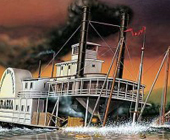Written by Francis Slobodnik
One of the tragedies of today’s industrial society is the de-personalization of just about everything. There remain few institutions today that offer personal service. Rare also are institutions where the owners or proprietors have a personal stake in their business or occupation.
The Steamboat Arabia Museum in Kansas City, Missouri is a jewel of family investment, and I’m not talking only about economic investment, but rather of personal investment.
This museum contains the entire cargo and remnants of a river boat that sank in the Missouri river on September 5, 1856.
In 1987 the Hawley family, who ran a heating and air conditioning service, saw a map marking the locations of sunken river boats at the home of a customer. They decided to dig up one riverboat, the Arabia, that was buried in the Kansas City area. Two family friends joined them in this incredible venture.
Due to erosion, the Missouri River changed course over time, and the Arabia was buried underground for over a century – along with all of its precious cargo. Lying 45-feet deep beneath a Kansas cornfield, the Arabia’s payload was protected from light and oxygen and was thus remarkably well preserved.
The two-hundred tons of cargo and boat wreckage were painstakingly dug up and hauled away to be kept frozen in a giant freezer in order to preserve the materials. Since that time, and for many years to come, they continue to delicately restore each and every object and then put it on display. The cargo is a snapshot of items that could be found in general stores all across the Midwest. Many would be shocked to see the beautiful and magnificent items in that cargo hold, articles that would put contemporary highbrow departments stores to shame.
The owners could have sold their findings for a great deal of money and enjoyed a comfortable retirement. Had they done so, the cargo would have been scattered across the four corners of the earth. The Hawley family and friends decided to create a museum where visitors could see the collection of all of the objects from the riverboat.
Even more amazing, to this very day, the family runs and maintains the museum. After visitors to the museum view a brief film telling the story of the find and the cargo, a member of the family personally appears and is there to answer any questions visitors may have.
This is a family that truly invested in their project. They take a great personal interest in the fostering of their exhibit. The film is shown many times a day to visitors. Imagine how many thousands of times the owners have presented themselves and answered all of the typical questions about the exhibit.
The Hawley family is an excellent example of heading in the direction of the book,  Return To Order. They could have hired directors and staff to run everything. They could have sat at home and collected their checks. Instead they chose to be a daily part of their find and that is their real treasure. It is not so much that they value the material value of the treasure; they value what the treasure represents.
Return To Order. They could have hired directors and staff to run everything. They could have sat at home and collected their checks. Instead they chose to be a daily part of their find and that is their real treasure. It is not so much that they value the material value of the treasure; they value what the treasure represents.
Oh, and by the way, they do not seek nor receive one dollar of government funding.



